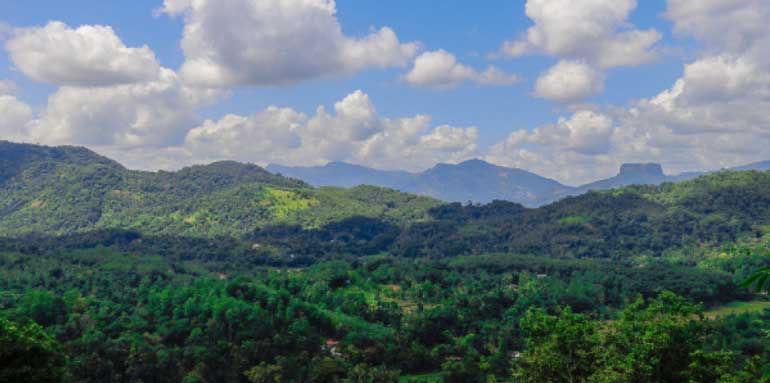Tuesday Dec 30, 2025
Tuesday Dec 30, 2025
Saturday, 14 January 2023 00:05 - - {{hitsCtrl.values.hits}}

Building on Sri Lanka’s natural capital can provide a pathway to attract investment, access finance, and design interventions with strong co-benefits and synergies
 As a developing tropical island nation, Sri Lanka is vulnerable to the impacts of climate change. Sea level rise, erosion, and storms affect the coastal zone while agricultural areas are threatened by erratic rainfall, droughts, floods, and soil degradation. Across the country and across key economic sectors, climate change already impacts livelihoods, lives, and human wellbeing, and is projected to become more severe in the coming decades.
As a developing tropical island nation, Sri Lanka is vulnerable to the impacts of climate change. Sea level rise, erosion, and storms affect the coastal zone while agricultural areas are threatened by erratic rainfall, droughts, floods, and soil degradation. Across the country and across key economic sectors, climate change already impacts livelihoods, lives, and human wellbeing, and is projected to become more severe in the coming decades.
Sri Lanka is also blessed with a rich biodiversity and a multitude of productive ecosystems. From cloud forests to grasslands, and from lowland rainforests, lakes, and coastal ecosystems such as salt marshes, seagrass beds, and coral reefs, the island is home to a significant range of habitats and associated species of animals and plants, many of which are endemic.
Particularly in light of the new Global Biodiversity Framework and the intergovernmental climate negotiations, how can Sri Lanka’s natural wealth help the country to address challenges such as climate change while also facilitating economic recovery and sustainable development?
The benefits of biodiversity
There are at least three ways in which biodiversity and ecosystems can be part of the solution and help to increase the resilience of human communities and systems.
First off, ecosystems provide a range of benefits, some of which can be directly expressed in monetary terms. These ecosystem services include provision of goods and ingredients for consumption, medicine, cosmetics, construction, and other purposes, prevention of erosion, regulation of air and water quality, protection against floods, storage of water, tourism and recreation opportunities, and many more.
Mangrove ecosystems, for example, have been estimated to provide services worth up to $ 50,000 per hectare in some cases, with $ 15,000 as the average value. Beyond these valuated benefits, natural ecosystems serve as animal habitats and hold intangible and hard-to-quantify aesthetic, cultural, or spiritual value, create a sense of place, and can improve mental health and resilience of nearby communities.
Secondly, while healthy ecosystems automatically provide the above-mentioned benefits to the environment, wildlife, and human communities, they can also be harnessed in targeted ways. Towards this end, ecosystem services can be incorporated into planning processes in direct, indirect, or hybrid ways.
Such nature-based solutions can, for example, take the form of green infrastructure such as green roofs, rain gardens, urban forests, urban wetlands, or urban agriculture that improve the resilience of human settlements by contributing to disaster risk reduction, flood control, food security, and sustainable livelihoods.
Beyond improving cities and infrastructure, nature also offers ways to directly boost economic growth in sustainable ways. For an island nation like Sri Lanka, investing in a blue economy holds significant potential. Blue economy measures could include ecosystem solutions in the fisheries sector, seaweed or seagrass cultivation, coastal zone management, aquaculture, coastal and marine tourism, ocean-based transportation, or renewable ocean energy.
On land, integrated nature-based solutions can transform food systems and enhance productivity, production diversity, and resilience through agroforestry, or work towards more sustainable, cost-effective, and circular land and water management.
Thirdly, actions related to ecosystem conservation, rehabilitation, restoration, and assisted growth can help to mobilise much-needed finance and investment. There are various financial instruments and mechanisms that connect to natural ecosystems and the protection of biodiversity, including green bonds, ecological restoration bonds, debt-for-nature swaps, ESG (environmental, social, and governance) investing, impact investing, carbon credits (both on the voluntary market and in relation to a centralised mechanism being set up under Article 6.4 of the Paris Agreement), biodiversity offsets (for instance, for afforestation or habitat restoration), natural capital finance, resource efficiency financing, or bioprospecting (the exploration of biodiversity for commercially valuable genetic and biochemical resources).
Other mechanisms that can incentivise ecosystem conservation and link them to economic growth are payments for reducing emissions from deforestation and forest degradation (REDD+), payments for ecosystem services (PES) mechanisms, ecosystem discounts for insurance premiums, eco-index insurance, or green mortgages.
Possible sources of finance for such interventions are varied and operate across all scales. Depending on available funding, nature-based solutions could take the form of national-level projects or public works, but also nature-based microfinance for local projects, such as in ecotourism or sustainable agriculture. Nature-based crowdfunding, donations, sale of conservation easements, special levies, or land trusts are potential other sources of biodiversity finance.
Aligning national and global goals
As highlighted in my previous column, the climate and biodiversity crises are neither separate nor are they confined to the country level. They are deeply interconnected global challenges—part of what can be called a “polycrisis”—but must be addressed first and foremost through local and national action.
Under the United Nations Framework Convention on Climate Change and the Paris Agreement, global goals relate to climate change mitigation (emission reduction and curbing of temperature rise), adaptation (changing systems to avoid adverse impacts and seize positive opportunities), addressing loss and damage (support for those affected by climate impacts beyond adaptation limits), and providing support for developing countries, including through finance and technology transfer.
Under the Convention on Biological Diversity and the new Kunming-Montreal Global Biodiversity Framework (GBF) adopted last month, global goals focus on biodiversity conservation and protected areas, halting species extinction, preserving genetic resources, halving food waste, and strengthening sustainable biodiversity management and usage. Furthermore, the GBF aims to mobilise at least $ 200 billion per year in financial flows from all sources to support these goals and ensure that adequate means of implementation are available to all Parties, particularly developing countries.
Individual countries communicate their contributions to these overarching goals through Nationally Determined Contributions (NDCs) and National Biodiversity Strategies and Action Plans (NBSAPs). Sri Lanka’s NDCs, for example, include sectors such as forestry, water, biodiversity, and coastal and marine, while the country’s NBSAPs reference climate impacts, biodiversity valuation, sustainable use of biodiversity, sustainable agriculture, and equitable sharing of biodiversity benefits, among other things.
Both documents contain targets related to the conservation, restoration, and sustainable management of soil, water, forests, wetlands, agrobiodiversity, and coastal and marine areas. Conserving natural ecosystems and biodiversity contributes to achieving these targets as well as mitigating climate change by acting as carbon sinks.
If national, local, and sector-specific plans and interventions are aligned with these commitments, they can better access finance from global funds (such as the Green Climate Fund and the Global Environmental Facility), multi- and bilateral entities, financial markets, the private sector, the insurance industry, repurposed subsidies, and other countries.
With the new biodiversity finance target, pledges made to several funds at the recent United Nations Climate Change Conference (COP27) in Sharm el-Sheikh, and a new upcoming global goal for climate finance, there is an important window of opportunity to link action on biodiversity and climate change.
Identifying synergies
Sri Lanka is endowed with valuable natural capital in the form of diverse ecosystems, fauna, and flora. Building on this capital in line with national and global commitments can provide a pathway to attract investment, access finance from a multitude of sources, and design interventions and policies with strong co-benefits and synergies.
If concrete, transparent, and well-designed actions are taken on different levels, they can not only prevent further biodiversity loss and preserve biodiversity benefits for future generations, but also utilise the full potential of ecosystems to address climate change, support economic growth, and mobilise investment from a multitude of sources.
(The writer works as Director – Research and Knowledge Management at SLYCAN Trust, a non-profit think tank based in Sri Lanka. His work focuses on climate change, adaptation, resilience, ecosystem conservation, just transition, human mobility, and a range of related issues. He holds a Master’s degree in Education from the University of Cologne, Germany and is a regular writer to several international and local media outlets.)